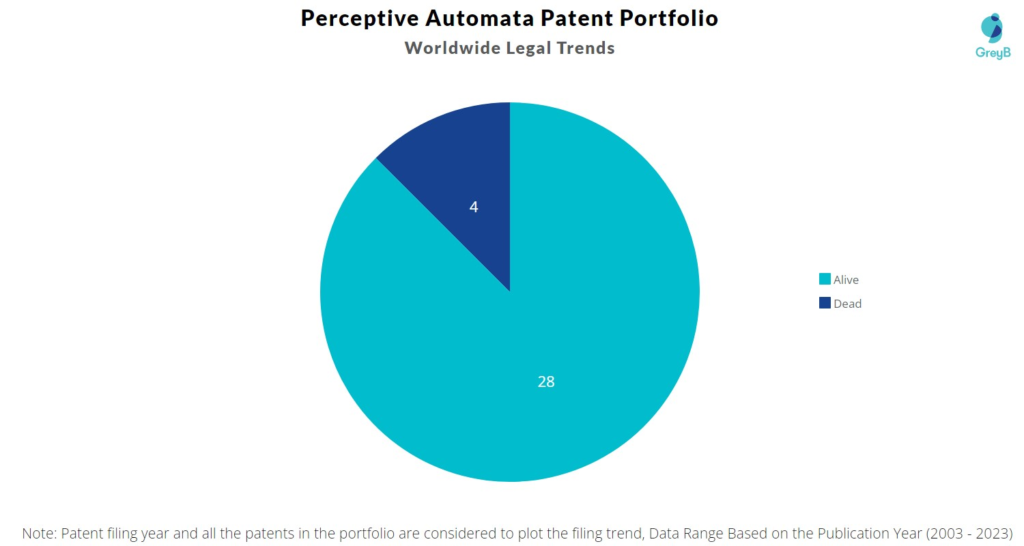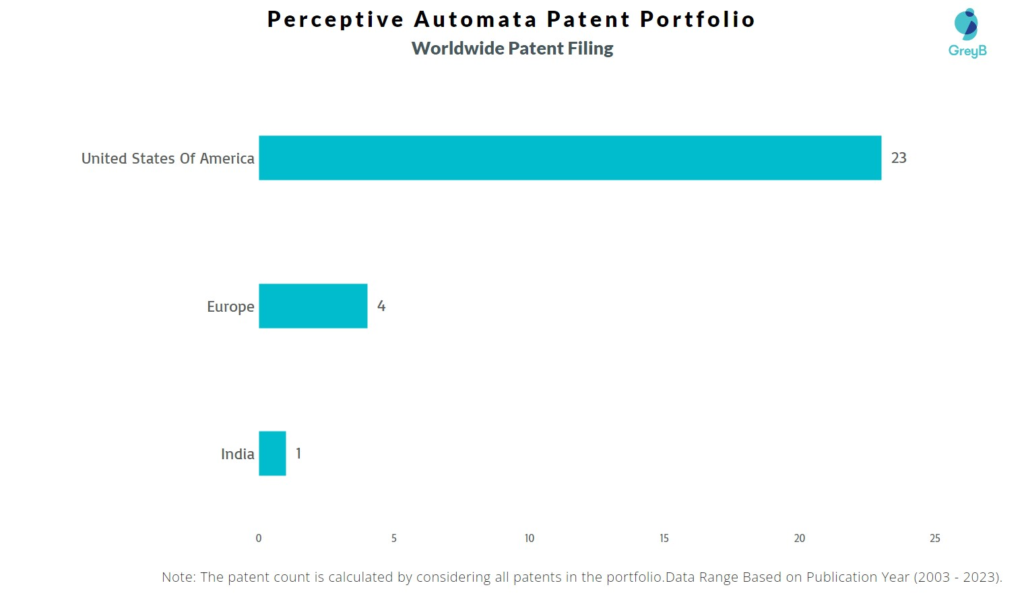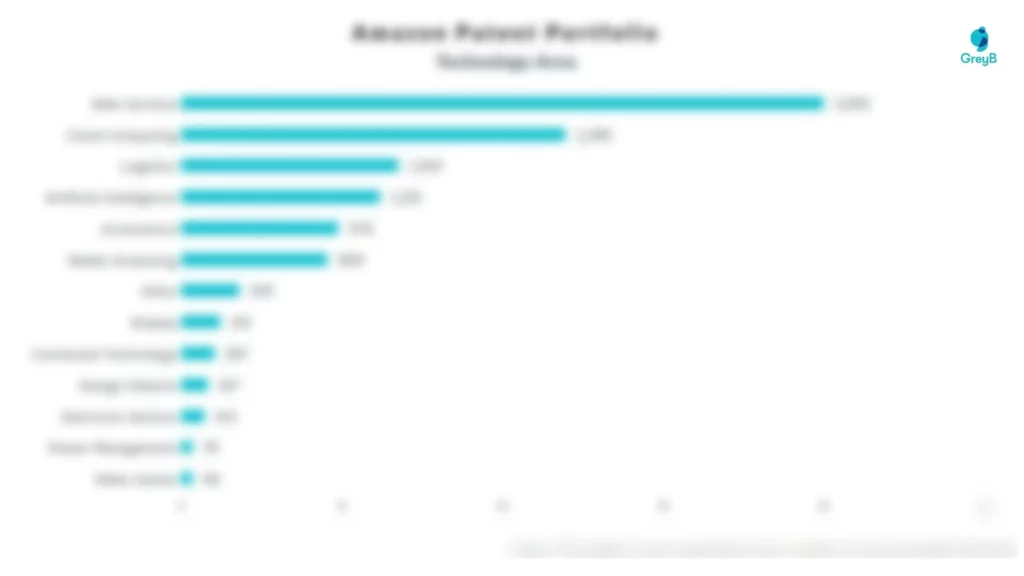Perceptive Automata has a total of 32 patents globally, out of which 17 have been granted. Of these 32 patents, more than 87% patents are active. United States of America is where Perceptive Automata has filed the maximum number of patents, followed by Europe and India. Parallelly, United States of America seems to be the main focused R&D centre and also is the origin country of Perceptive Automata.
Perceptive Automata was founded in the year 2015. The Company enables those vehicles to understand what people might do next so they can navigate safely and smoothly around humans.
Do read about some of the most popular patents of Perceptive Automata which have been covered by us in this article and also you can find Perceptive Automata patents information, the worldwide patent filing activity and its patent filing trend over the years, and many other stats over Perceptive Automata patent portfolio.
How many patents does Perceptive Automata have?
Perceptive Automata has a total of 32 patents globally. These patents belong to 13 unique patent families. Out of 32 patents, 28 patents are active.
How Many Patents did Perceptive Automata File Every Year?

Are you wondering why there is a drop in patent filing for the last two years? It is because a patent application can take up to 18 months to get published. Certainly, it doesn’t suggest a decrease in the patent filing.
| Year of Patents Filing or Grant | Perceptive Automata Applications Filed | Perceptive Automata Patents Granted |
| 2023 | – | 8 |
| 2022 | – | 3 |
| 2021 | 11 | 4 |
| 2020 | 12 | 1 |
| 2019 | 6 | 1 |
| 2018 | 2 | – |
| 2017 | 1 | – |
How many Perceptive Automata patents are Alive/Dead?

How Many Patents did Perceptive Automata File in Different Countries?

Countries in which Perceptive Automata Filed Patents
| Country | Patents |
| United States Of America | 23 |
| Europe | 4 |
| India | 1 |
Where are Research Centres of Perceptive Automata Patents Located?
The Research Centre for all the Perceptive Automata patents is the United States of America.
10 Best Perceptive Automata Patents
USD928803S1 is the most popular patent in the Perceptive Automata portfolio. It has received 17 citations so far from companies like Winkk, Inc., Apple and Microsoft Corporation.
Below is the list of 10 most cited patents of Perceptive Automata:
| Publication Number | Citation Count |
| USD928803S1 | 17 |
| US10614344B2 | 16 |
| US10402687B2 | 13 |
| US20210182604A1 | 13 |
| US20210114627A1 | 9 |
| USD928804S1 | 8 |
| USD928177S1 | 5 |
| US11518413B2 | 4 |
| US20210357662A1 | 3 |
| US20210182605A1 | 3 |
What Percentage of Perceptive Automata US Patent Applications were Granted?
Perceptive Automata (Excluding its subsidiaries) has filed 20 patent applications at USPTO so far (Excluding Design and PCT applications). Out of these 8 have been granted leading to a grant rate of 100.0%.
Below are the key stats of Perceptive Automata patent prosecution at the USPTO.

Which Law Firms Filed Most US Patents for Perceptive Automata?
| Law Firm | Total Applications | Success Rate |
| Fenwick & West Llp | 20 | 100.00% |
List of Perceptive Automata Patents
| Perceptive Automata Patents | Title |
| US11772663B2 | Neural Network Based Modeling And Simulation Of Non-Stationary Traffic Objects For Testing And Development Of Autonomous Vehicle Systems |
| US11763163B2 | Filtering User Responses For Generating Training Data For Machine Learning Based Models For Navigation Of Autonomous Vehicles |
| US11753046B2 | System And Method Of Predicting Human Interaction With Vehicles |
| US11733703B2 | Automatic Braking Of Autonomous Vehicles Using Machine Learning Based Prediction Of Behavior Of A Traffic Entity |
| US11667301B2 | Symbolic Modeling And Simulation Of Non-Stationary Traffic Objects For Testing And Development Of Autonomous Vehicle Systems |
| US11615266B2 | Adaptive Sampling Of Stimuli For Training Of Machine Learning Based Models For Predicting Hidden Context Of Traffic Entities For Navigating Autonomous Vehicles |
| US11572083B2 | Neural Network Based Prediction Of Hidden Context Of Traffic Entities For Autonomous Vehicles |
| US11551030B2 | Visualizing Machine Learning Predictions Of Human Interaction With Vehicles |
| US11520346B2 | Navigating Autonomous Vehicles Based On Modulation Of A World Model Representing Traffic Entities |
| US11518413B2 | Navigation Of Autonomous Vehicles Using Turn Aware Machine Learning Based Models For Prediction Of Behavior Of A Traffic Entity |
| US11467579B2 | Probabilistic Neural Network For Predicting Hidden Context Of Traffic Entities For Autonomous Vehicles |
| US11126889B2 | Machine Learning Based Prediction Of Human Interactions With Autonomous Vehicles |
| USD928803S1 | Display Panel Of A Programmed Computer System With A Graphical User Interface |
| USD928804S1 | Display Panel Of A Programmed Computer System With A Graphical User Interface |
| USD928177S1 | Display Panel Of A Programmed Computer System With A Graphical User Interface |
| US10614344B2 | System And Method Of Predicting Human Interaction With Vehicles |
| US10402687B2 | System And Method Of Predicting Human Interaction With Vehicles |
| US20210356968A1 | Scenario Identification For Validation And Training Of Machine Learning Based Models For Autonomous Vehicles |
| US20210357662A1 | Ground Truth Based Metrics For Evaluation Of Machine Learning Based Models For Predicting Attributes Of Traffic Entities For Navigating Autonomous Vehicles |
| US20210182604A1 | System And Method Of Predicting Human Interaction With Vehicles |
| US20210182605A1 | System And Method Of Predicting Human Interaction With Vehicles |
| US20210133500A1 | Generating Training Datasets For Training Machine Learning Based Models For Predicting Behavior Of Traffic Entities For Navigating Autonomous Vehicles |
| US20210114627A1 | Neural Networks For Navigation Of Autonomous Vehicles Based Upon Predicted Human Intentions |
| EP4149807A1 | Turn Aware Machine Learning For Traffic Behavior Prediction |
| EP4149808A1 | Scenario Identification For Validation And Training Of Machine Learning Based Models For Autonomous Vehicles |
| EP3918590A4 | Neural Network Based Navigation Of Autonomous Vehicles Through Traffic Entities |
| EP3701418A4 | System And Method Of Predicting Human Interaction With Vehicles |
| IN202147039120A | Neural Network Based Navigation Of Autonomous Vehicles Through Traffic Entities |
| WO2021231985A1 | Turn Aware Machine Learning For Traffic Behavior Prediction |
| WO2021231986A1 | Scenario Identification For Validation And Training Of Machine Learning Based Models For Autonomous Vehicles |
| WO2020160276A1 | Neural Network Based Navigation Of Autonomous Vehicles Through Traffic Entities |
| WO2019112912A1 | System And Method Of Predicting Human Interaction With Vehicles |
What are Perceptive Automata key innovation segments?
What Technologies are Covered by Perceptive Automata?

The chart below distributes patents filed by Perceptive Automata
